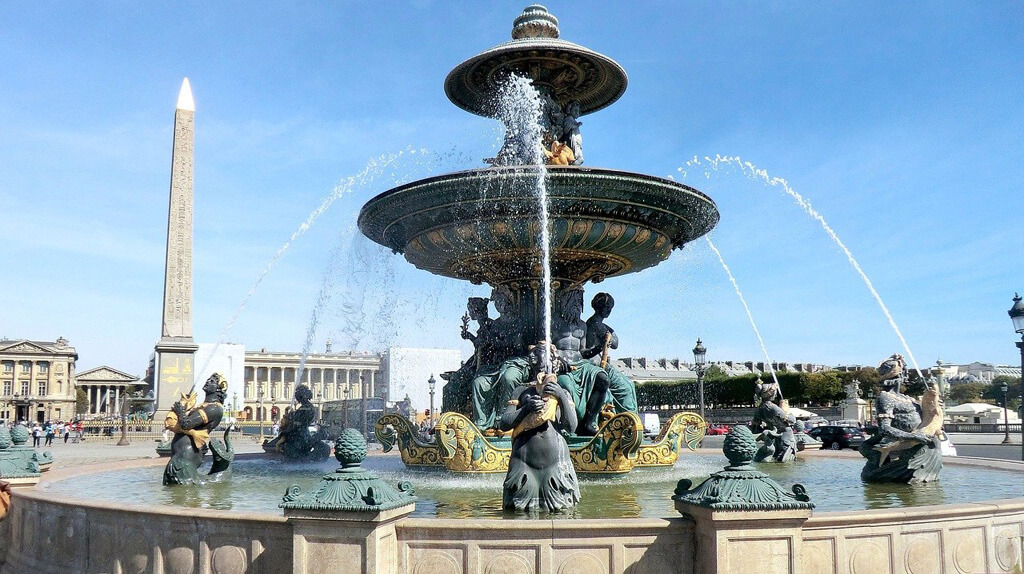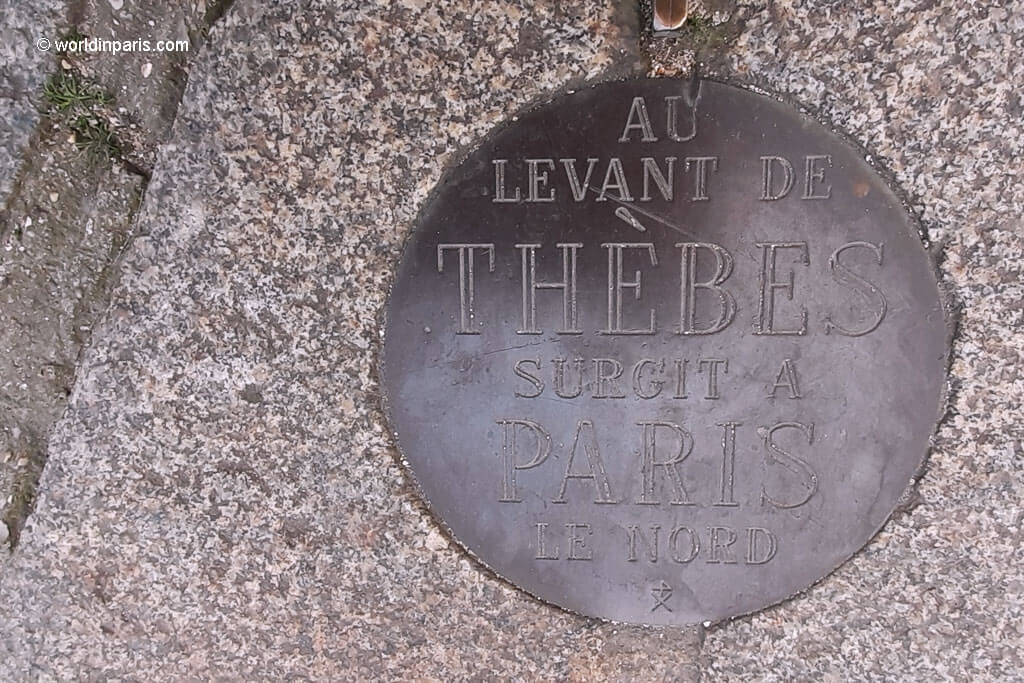Place de la Concorde, in Paris 8, is one of the five Royal Squares in Paris and the symbol of classic French elegance. In the center of this square stands today the Luxor Obelisk, Paris’ quirkiest landmark brought directly from Egypt. Built in the 13th century BC, the Place de la Concorde Obelisk is the oldest monument in Paris!
The Egyptian Obelisk in Paris is also the world’s biggest sundial: the gnomon of this dial is the Luxor Obelisk itself, which indicates the time by its shadow. From the base of the ancient stone pillar, the solstice curves, the equinox lines, and the hour lines were marked with bronze-colored heat-sealed bands (on the pedestrian areas) and with 400 bronze nails (on the pavement).

Where did the Obelisk in Paris come from? Why was the Luxor Obelisk given to France?
If you are a curious wanderer, you may notice on the line of the 12th hour a small plaque with a very cryptic message “Au levant the THEBES surgit a PARIS le Nord,” (In the east of THEBES arises in PARIS the north) which explains in few words the incredible voyage of the Egyptian Obelisk from Thebes to Paris. Go on reading to learn the Luxor Obelisk history.

The Luxor Obelisk in Paris – A Gift from Egypt to France
Why was the Luxor Obelisk given to France?
One of the most famous Paris landmarks, the Egyptian Obelisk in Paris was a diplomatic gift. In 1830, the Sultan and Viceroy of Egypt Mehemet Ali decided to offer the two obelisks standing in front of the Luxor Temple (Thebes, Egypt) to King Charles X of France. It was a gesture of friendship and gratitude for the deciphering of Egyptian hieroglyphs by Champollion.
The Luxor Obelisks measure 22 meters high and weigh 220 tons each, and they were built under the reign of Pharaon Ramses II. The French King, of course, accepted the gifts.
From Thebes to Paris – The Obelisk’s Incredible Journey

Transporting the Egyptian Obelisk from Thebes in Egypt to Paris in France was not an easy task. The journey took six years of preparation, resources, and execution until the Luxor Obelisk arrived in Paris. The plaques on two sides of the Egyptian Obelisk at Place de la Concorde represent the long tribulations of the Luxor Obelisk from Egypt, with the dismounting, transport, and reassembly.
A custom-made barge (The Louxor) built in the shipyards of Toulon was sailed to Egypt to load the Luxor Obelisk. This was a flat-bottomed single-use barge the dimensions of which were studied to sail through the bridges over the Seine River. To reach the Obelisk’s position in Thebes, 300 men dug a new canal.
On 19 December 1831, the granite column was near the Louxor, where it was loaded and moored. The barge was ready to leave on Christmas Day, but the Nile River was at its lowest water level and the Louxor, too heavy, could not sail. The crew had to wait on-site for the flood, which wasn’t there for six months.
But in June 1832, an epidemic of dysentery sidelined half the crew, so it was not until 25 August that the Louxor could leave Thebes, almost 17 months after its departure from Toulon!
After sailing the Nile River, the barge arrived in Alexandria (Egypt) on 2 January 1833, where the Sphinx, the first operational steamship, was waiting to tow it to Paris through the Mediterranean Sea and then the Atlantic Ocean. A storm, however, delayed the journey through the Mediterranean Sea to 1 April 1833.
The convoy reached Rouen in France on 14 September. Once again, it was necessary to wait for the flooding of the Seine to sail up the river and reach Paris on 18 December 1833. The engineer in charge of the Obelisk’s conveyance, Apollinaire Lebas, concluded his journey as follows: “The second obelisk will be convoyed by whoever wants, but it will not be me.“
Choosing the Right Location for the Egyptian Obelisk in Paris
The Luxor Temple Obelisk, however, did not find its current place in Paris until three years later. A puritan scandal doubled a long national debate on the monument’s location: King Louis-Philippe found the Obelisk’s base obscene!
On the base, four baboons were standing on their hind legs and raising their arms to honor the sun, proudly exposing their male anatomy capable of shocking the prude Parisian souls of the time. Therefore, the City of Paris decided to build a new – less suggestive base – while the original pedestal was dumped in the Louvre Museum.
King Louis-Philippe decided on the Obelisk’s location. Having a monument totally strange to the History of France in Place de la Concorde, a high symbol of the French Revolution, looked like a good compromise.

The Erection of the Paris Obelisk in Place de la Concorde (and a Big Fail)

The erection of the Luxor Obelisk in Paris took place on 25 October 1836 in Place de la Concorde. The technical feat, orchestrated by Apollinaire Lebas, took place under the curious eyes of 200,000 people – and the king himself, on the balcony of the Hôtel de la Marine.
To raise the monolith vertically, an exceptional lifting device was built, and it was operated by three hundred and fifty gunners and sailors. Apollinaire Lebas directed the maneuver in the shadow of the monolith. A question of honor: if the erection failed, he must not survive.
In the middle of the afternoon, the Paris Obelisk finally found its final vertical position at Place de la Concorde. However, it seems that somebody did not read the Obelisk’s installation manual well (or perhaps the authorities in charge were all too busy debating about the baboons?) because the Obelisk’s historical alignment was neglected. Indeed, the Obelisk at Place de la Concorde has undergone a 90º counterclockwise rotation, and the face originally to the East has ended up in the North! This explains the cryptic message on the plaque – what is in the East (Levant) in Thebes is now in the North in Paris.
And What Happened to the Second Luxor Obelisk?
For the second obelisk, Paris basically said, “Non, merci!”
After all the technical difficulties encountered with the first Luxor Obelisk, France never went to pick up the second one. French President François Mitterrand officially “returned” the second obelisk to Egypt in 1981.

